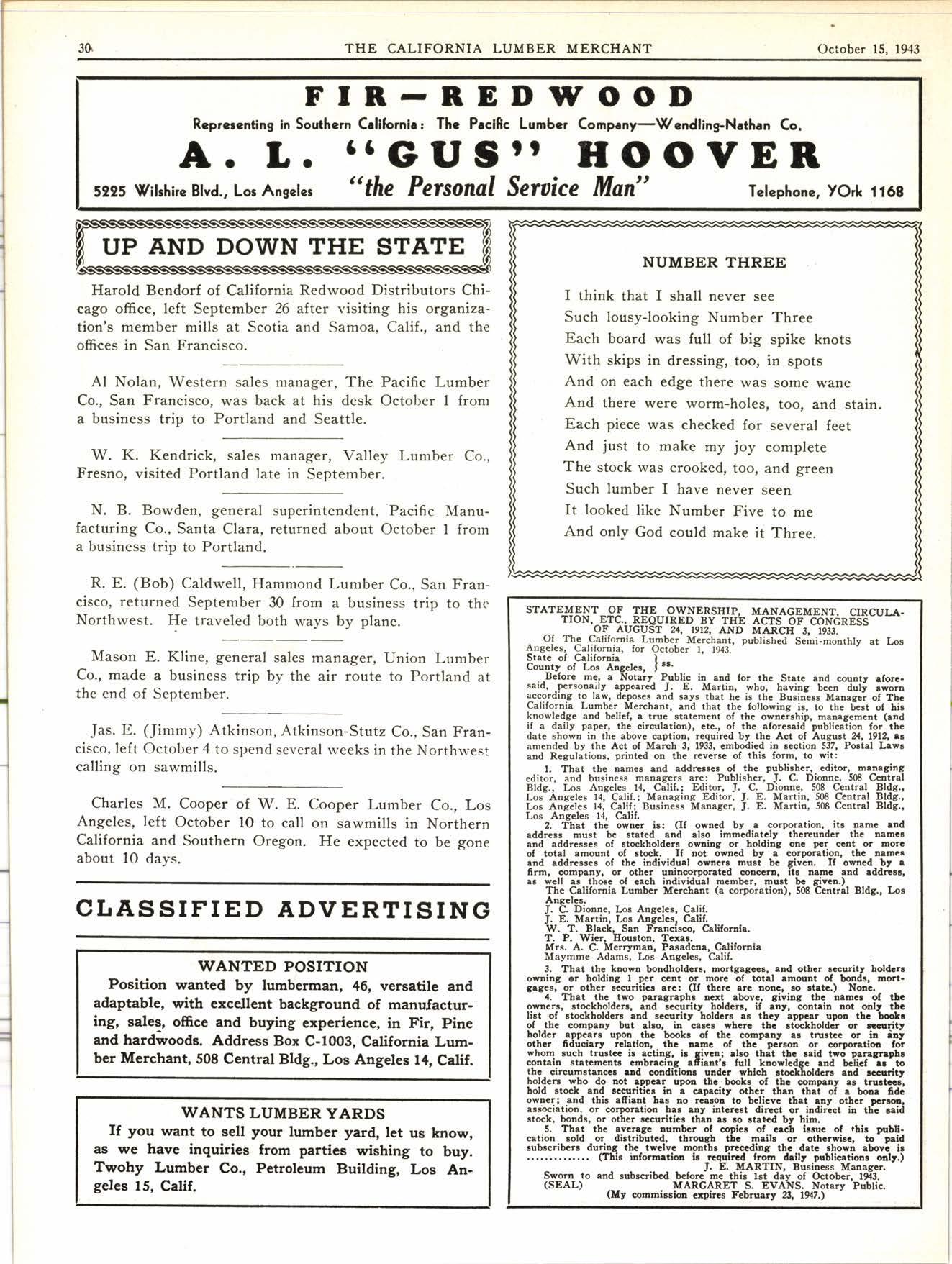
3 minute read
suDlttt & cHRlsrxtfsotf, IIIG, f,urnber and Shipping
Debate Public Regulation of Forest Lands
(Continued lrom Page 27) land management can be required by law, but to achieve them by education, economic inducement and public and private cooperation is our American way of getting things done.
The sooner we stop treating forestry as a perpetual emerg'ency the more progress we will make. People do not invest in things they are uncertain about. American forestry needs less agitation and more silviculture.
No country has solved its forest land problem without some public regulation, and this country will not either. Certain simple requirements are necessary and desirable but they should be based on the experience of forest land owners in each region and administered by state law. Federal regulation would force action more quickly, but its consequence would be substitution of public for private forest ownership. Those who want that will favor Federal regulation.
There will be no national shortage of timber. There are and will be local and regional shortages which should be rectified. Fundamentally, and except for the present fantastic wartime stimulation, American forests need markets more than they need more legislation.
The Chief Forester has criticized as "misleading" some of the information published by the forest industries. The Forest Service for half a century has had a gloomy approactr to the whole conservation problem. This attitude is traditional, impregnable, and perhaps almost professional. It is the logical approach to a program of intended domination of a great industry by a federal bureau. The forest industries see a simpler, more constructive and a safer answer to the forest problem than is to be found in more federal laws.
The information program of the forest industries has created a lively curiosity about our forests. The public was never more keenly aware of the dangers of forest fires or the importance of junior forests or the possibilities in "Tree Farms." This public awareness has encouraged better forest practices in the industry itself. For this reason the forest industries should continue this industry information.
Officers Re-eleded
The following officers were re-elected at the 46th annual meeting of the National Hardwood Lumber Association held in Chicago on September 1G17.
President, Abbott M. Fox, fron Mountain, Mich.; vicepresidents, D. C. Maclea, Baltimore, Md., George H. Henderson, Keltys, Tex., F. W. Hutcheson, Huntsville, Ontario, Canada; secretary-treasurer, John W. McClure, Chicago, Ill.
With Scrn Pedro Lumber Co.
Fred Kozac is back with the San Pedro Lumber Co. and holding down his old desk in their Los Angeles office. For the past nine months he was with the Los AngelesAlbuquerque Express.
EstimatedConsumption of lfestern Pine Lumbcr for Fourth Quarter of 1943
Portland, Oregon, Sept. 30.-An estimate of the probable consumption of lumber from the Western Pine region for the fourth quarter of 1943 is given in a statement issued by the Western Pine Association. The statement follows:
Now that the country's war plant program is substantially completed the principal braki on the production of all critical items is the almost universal shortage of manpower. Recent accounts from Washington all agree that the labor situation in the West is as tight as it is anywhere in the nation.
The producers of Idaho White Pine, Ponderosa Pine and Sugar Pine are just as hard pressed for labor as are any other war industries in the area. Early in the war they lost some of their best employees to new cost plus industries which rvere not operating under ceiling prices. Even now, with the critical nature of the industry's output well recognized, experienced men are being lost to the armed forces, to farm employers who can ofier almost automatic draft exemption and no withholding tax, and a few to other industries.

Evidence that there is no labor hoarding in the Western Pine industry is furnished by the production of 4318 million feet of lumber in the first nine months of this year. This is bat 6.7 per cent behind last year and only 7.7 per cent under the all-time high set by the industry in 1941. It is the best record of any principal section of the lumber industry.
During the third quarter the industry made some progress toward rebuilding stocks from which to maintain next winter's shipments but the insistant war demand for pine boxes and crating, which resulted in Limitation Order L-DU, kept the stock increase below normal. Stocks o!
1139 million feet are up 172 million feet in the past three months but still are 287 million feet under a year ago.
Based upon general predictions and all other available information regarding the industry's ability to make and ship lumber, it is expected that during the fourth quarter of 1943 the shipments (consumption) of Western Pine lumber will be about 1410 million feet, or 10 per cent under the fourth quarter of last year. This prediction contemplates a substantial reduction of stocks during the quarter, so that the year's shipments from the mills will exceed production by I75 to 200 million feet.
PLYPANELS-PLYFORM-PLYWALL
THE
Mciling Address: Telephone: P. O. Box 126, Vemon Station Klmboll2l4l 4940 District Boulevcnd










